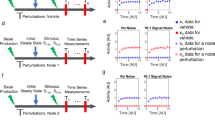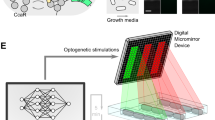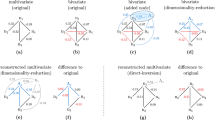Abstract
Predictions of physical and functional links between cellular components are often based on correlations between experimental measurements, such as gene expression. However, correlations are affected by both direct and indirect paths, confounding our ability to identify true pairwise interactions. Here we exploit the fundamental properties of dynamical correlations in networks to develop a method to silence indirect effects. The method receives as input the observed correlations between node pairs and uses a matrix transformation to turn the correlation matrix into a highly discriminative silenced matrix, which enhances only the terms associated with direct causal links. Against empirical data for Escherichia coli regulatory interactions, the method enhanced the discriminative power of the correlations by twofold, yielding >50% predictive improvement over traditional correlation measures and 6% over mutual information. Overall this silencing method will help translate the abundant correlation data into insights about a system's interactions, with applications ranging from link prediction to inferring the dynamical mechanisms governing biological networks.
This is a preview of subscription content, access via your institution
Access options
Subscribe to this journal
Receive 12 print issues and online access
$259.00 per year
only $21.58 per issue
Buy this article
- Purchase on SpringerLink
- Instant access to full article PDF
Prices may be subject to local taxes which are calculated during checkout





Similar content being viewed by others
References
Buchanan, M., Caldarelli, G., De Los Rios, P., Rao, F. & Vendruscolo, M. (eds). Networks in Cell Biology (Cambridge University Press, 2010).
Ideker, T. & Sharan, R. Protein networks in disease. Genome Res. 18, 644–652 (2008).
Kann, M.G. Protein interactions and disease: computational approaches to uncover the etiology of diseases. Brief. Bioinform. 8, 333–346 (2007).
Albert, R. Scale-free networks in cell biology. J. Cell Sci. 118, 4947–4957 (2005).
Barabási, A.-L. & Oltvai, Z.N. Network biology: understanding the cell's functional organization. Nat. Rev. Genet. 5, 101–113 (2004).
Vidal, M., Cusick, M.E. & Barabási, A.-L. Interactome networks and human disease. Cell 144, 986–998 (2011).
Rual, J.F. et al. Towards a proteome-scale map of the human protein-protein interaction network. Nature 437, 1173–1178 (2005).
Yu, H. et al. High-quality binary protein interaction map of the yeast interactome network. Science 322, 104–110 (2008).
Braun, P. et al. An experimentally derived confidence score for binary protein-protein interactions. Nat. Methods 6, 91–97 (2009).
Krogan, N.J. et al. Global landscape of protein complexes in the yeast Saccharomyces cerevisiae. Nature 440, 637–643 (2006).
Costanzo, M. et al. The genetic landscape of a cell. Science 327, 425–431 (2010).
Ramani, A.K. et al. A map of human protein interactions derived from co-expression of human mRNAs and their orthologs. Mol. Syst. Biol. 4, 180–195 (2008).
Barzel, B. & Biham, O. Quantifying the connectivity of a network: the network correlation function method. Phys. Rev. E 80, 046104 (2009).
Eisen, M.B. et al. Cluster analysis and display of genome-wide expression patterns. Proc. Natl. Acad. Sci. USA 95, 14863–14868 (1998).
Butte, A.J. & Kohane, I.S. Mutual information relevance networks: functional genomic clustering using pairwise entropy measurements. Pac. Symp. Biocomput. 5, 415–426 (2000).
Margolin, A.A. et al. ARACNE: an algorithm for the reconstruction of gene regulatory networks in a mammalian cellular context. BMC Bioinformatics 7, S7 (2006).
Guo, S. et al. Uncovering interactions in the frequency domain. PLoS Comput. Biol. 4, e1000087 (2008).
Faith, J.J. et al. Large-scale mapping and validation of Escherichia coli transcriptional regulation from a compendium of expression profiles. PLoS Biol. 5, e8 (2007).
Marbach, D. et al. Wisdom of crowds for robust gene network inference. Nat. Methods 9, 796–804 (2012).
Lezon, T.R. et al. Using the principle of entropy maximization to infer genetic interaction networks from gene expression patterns. Proc. Natl. Acad. Sci. USA 103, 19033–19038 (2006).
Ma, S. et al. An Arabidopsis gene network based on the graphical Gaussian model. Genome Res. 17, 1614–1625 (2007).
Han, L. & Zhu, J. Using matrix of thresholding partial correlation coefficients to infer regulatory network. Biosystems 91, 158–165 (2008).
Chen, L. & Zheng, S. Studying alternative splicing regulatory networks through partial correlation analysis. Genome Biol. 10, R3 (2009).
Peng, J. et al. Partial correlation estimation by joint sparse regression models. J. Am. Stat. Assoc. 104, 735–746 (2009).
Yuan, Y. et al. Directed Partial Correlation: inferring large-scale gene regulatory network through induced topology disruptions. PLoS ONE 6, e16835 (2011).
Adamic, L.A. & Adar, E. Friends and neighbors on the web. Soc. Networks 25, 211–230 (2003).
Alon, U. An Introduction to Systems Biology: Design Principles of Biological Circuits (Chapman & Hall, London, 2006).
Karlebach, G. & Shamir, R. Modeling and analysis of gene regulatory networks. Nat. Rev. Mol. Cell Biol. 9, 770–780 (2008).
Caldarelli, G., Capocci, A., De Los Rios, P. & Muñoz, M.A. Scale-free networks from varying vertex intrinsic fitness. Phys. Rev. Lett. 89, 258702 (2002).
Liu, Y.-Y., Slotine, J.-J. & Barabási, A.-L. Observability of complex systems. Proc. Natl. Acad. Sci. USA 110, 2460–2465 (2013).
Erdős, P. & Rényi, A. On the evolution of random graphs. Publications Math. Inst. Hungarian Acad. Sci. 5, 17–61 (1960).
Albert, R., Jeong, H. & Barabási, A.-L. Error and attack tolerance of complex networks. Nature 406, 378–382 (2000).
Cohen, R., Erez, K., Ben-Avraham, D. & Havlin, S. Resilience of the Internet to random breakdowns. Phys. Rev. Lett. 85, 4626–4628 (2000).
Bollobás, B. The Evolution of Random Graphs—the Giant Component. in Random Graphs 2nd ed. (Cambridge University Press, 2001).
Stauffer, D. & Aharony, A. Introduction to Percolation Theory (CRC Press, 1994).
Cohen, R. & Havlin, S. Complex Networks: Structure, Robustness and Function (Cambridge University Press, 2010).
Venkatesan, K. et al. An empirical framework for binary interactome mapping. Nat. Methods 6, 83–90 (2009).
Kauffman, S. The ensemble approach to understand genetic regulatory networks. Physica A 340, 733–740 (2004).
Marks, D.S., Hopf, T.A. & Sander, C. Protein structure prediction from sequence variation. Nat. Biotechnol. 30, 1072–1080 (2012).
Barabási, A.-L. & Albert, R. Emergence of scaling in random networks. Science 286, 509–512 (1999).
Albert, R. & Barabási, A.-L. Statistical mechanics of complex networks. Rev. Mod. Phys. 74, 47–97 (2002).
Caldarelli, G. Scale-free Networks (Oxford University Press, 2007).
Acknowledgements
We thank B. Alipanahi and B. Frey for their valuable insights, A. Sharma, F. Simini, J. Menche, S. Rabello, G. Ghoshal, Y.-Y. Liu, T. Jia, M. Pósfai, C. Song, Y.-Y. Ahn, N. Blumm, D. Wang, Z. Qu, M. Schich, D. Ghiassian, S. Gil, P. Hövel, J. Gao, M. Kitsak, M. Martino, R. Sinatra, G. Tsekenis, L. Chi, B. Gabriel, Q. Jin and Y. Li for discussions, and S.S. Aleva, S. Morrison, J. De Nicolo and A. Pawling for their support. This work was supported by the US National Institutes of Health (NIH), Center of Excellence of Genomic Science (CEGS), Grant number NIH CEGS 1P50HG4233; and the NIH, award number 1U01HL108630-01; DARPA Grant Number 11645021; DARPA Social Media in Strategic Communications project under agreement number W911NF-12-C-0028; the Network Science Collaborative Technology Alliance sponsored by the US Army Research Laboratory under agreement number NS-CTA W911NF-09-02-0053; the Office of Naval Research under agreement number N000141010968; and the Defense Threat Reduction Agency awards WMD BRBAA07-J-2-0035 and BRBAA08-Per4-C-2-0033.
Author information
Authors and Affiliations
Contributions
Both authors designed the research and wrote the paper. B.B. analyzed the empirical data, and did the analytical and numerical calculations.
Corresponding author
Ethics declarations
Competing interests
The authors declare no competing financial interests.
Supplementary information
Supplementary Text and Figures
Supplementary Note (PDF 1063 kb)
Rights and permissions
About this article
Cite this article
Barzel, B., Barabási, AL. Network link prediction by global silencing of indirect correlations. Nat Biotechnol 31, 720–725 (2013). https://doi.org/10.1038/nbt.2601
Received:
Accepted:
Published:
Issue date:
DOI: https://doi.org/10.1038/nbt.2601
This article is cited by
-
Widening the landscape of transcriptional regulation of green algal photoprotection
Nature Communications (2023)
-
Reviving a failed network through microscopic interventions
Nature Physics (2022)
-
An adaptive fault detection and root-cause analysis scheme for complex industrial processes using moving window KPCA and information geometric causal inference
Journal of Intelligent Manufacturing (2021)
-
Revealing the predictability of intrinsic structure in complex networks
Nature Communications (2020)
-
An effective approach for causal variables analysis in diesel engine production by using mutual information and network deconvolution
Journal of Intelligent Manufacturing (2020)



